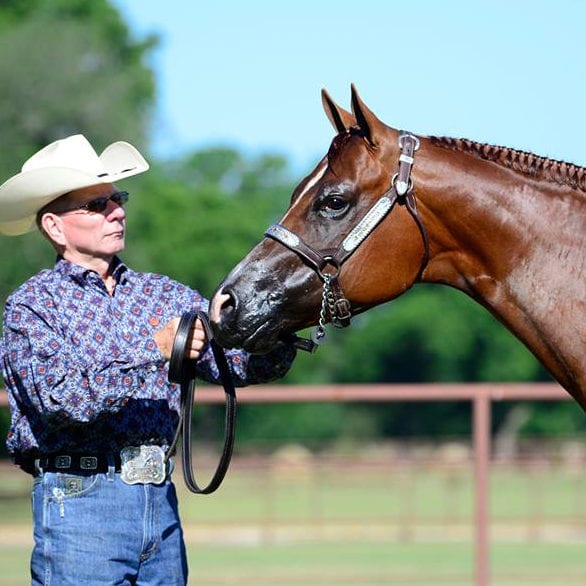People who are generally unfamiliar with showing halter tend to think it doesn’t involve much.
“You just walk in, trot past a judge, and set up. How hard can it be?”
Right…
Many folks just simply cannot imagine that there is a great deal of skill involved and that halter exhibitors don’t just “show up.”
Halter is a class that is incredibly detail oriented and those at the top of their game spend just as much time perfecting their horses and their craft as those in the saddle.
GoHorseShow spoke with the legendary halter trainer, Ted Turner who has amassed more World Championships than anyone, not just in the halter industry, but in AQHA history. We asked him to give us ten quick tips to make the most out of showing in a halter class.
1) The Word “Whoa” Is Your Best Friend
“The word ‘whoa’ is the most important word that the horse needs to know,” says Turner.
As you condition and prepare your horse for the show pen, you should be constantly making sure they know the word whoa and what it means. This is imperative for achieving a good set up and getting your horse shown to the best of your ability.
Turner also said that you should have a formula, or a plan, for setting the horse up and be sure to follow that every single time.
“I start with the passenger (right) side hind foot and set that one first. Then, the driver’s side (left) hind,” he said. “From there you move the passenger side front foot, with your hand placed on the withers to help get it where you want it, and finally, the driver’s side front, where I move my hand to the shoulder to help me.”
Here’s the kicker. Turner said after placing each foot, the handler needs to say whoa.
If your horse is unresponsive to whoa, you’re never going to get a good set up and you’re not going to get your horse shown.
2) Stop Running Around the Cone
For some unknown reason, a lot of people don’t quite know how to navigate the cone properly.
Turner said, “It looks a lot more professional to speed up your walk and have your horse stay right next to you in a smooth jog than to run around the cone like you’re in a showmanship class.”
Train your horse to jog next to you at home when you speed up your walk and this will pay in dividends in the show pen.
“Don’t do a sharp, hard left turn around the cone, either,” said Turner. “This isn’t a pattern class, so you need to maintain a nice, smooth cadence around the cone. Don’t do a big circle around it either.”
3) Make Sure Your Halter Fits
“If you wear a size 32 pant, you buy a size 32 pant, and they fit nice and snug like they should,” said Turner. “You don’t buy a size 34 or 28. The same goes for the halter. You don’t want it cutting the air off, but it should fit nice and snug.”
Too often, exhibitors have their horses in an ill-fitting halter, and often times that halter is too big or too loose. Turner says he sees halters that are set too low on the nose and do not come up under the jowls as it should.
Make sure your halter is adjusted properly and fits your horse well. It speaks volumes to the judges.
“A halter doesn’t need to be fancy either,” said Turner. “Just clean and fitted properly. That is the most important.”
4) … And Your Chain is Adjusted Properly
For Turner, there really is no right or wrong chain length, but there are a couple things to consider.
Number one, make sure the length works with the horse.
“You are trying to do everything possible to show this horse to the best of its ability, so the length needs to simply be appropriate for you to do that,” he said. “You also need to keep in mind that you need to do everything you can to make sure your equipment looks the best.”
Clearly, chains that are ridiculously long or short don’t do that. One of the major no-nos in halter is to clip the chain back to itself if the excess is too long and you desire it to be shorter.
Take a link, or two, or however many it takes out so the chain clips to the halter without running it through. It’s clean, not bulky and appears professional.
Otherwise, it’s just tacky.
5) Please Match Your Belt and Your Boots
Turner doesn’t have many rules when it comes to halter fashion, but… please make sure you match your belt with your boots.
“If you are wearing a brown belt, wear brown boots,” he said. “Black belt. Black Boots.”
Turner also prefers white hats in the show pen instead of black and make sure your pants are long enough.
“No ankle swimmers,” he said.
And here’s a fun fact for you. Turner is incredibly superstitious, so he recommends avoiding the colors green and yellow at all costs.
“I’m not big on green and yellow,” he said. “They’re unlucky.”
Obviously, he does not feel that way about the color orange.
6) Look Where You Want to Go, and You’ll Get There
Another big problem area for many halter exhibitors is properly tracking their horse to the judge.
Turner said, “Look up at the judge and walk the horse to the judge. Your horse needs to be broke enough to track straight to the judge without the head or anything turning. If you look down, that’s not courteous to the judges and you aren’t going to walk straight.”
Just like when riding, if you look down, things go south. Same when it comes to tracking in halter, you have to look where you want to go and your horse needs to be a willing follower.
Turner said if you need to stop your horse and readjust, that’s fine, just make sure you are walking the horse directly to the judge when all is said and done.
7) Pick a Good Standing Position to Show
Back in the old days, exhibitors would move from the left to the right depending on where the judge was during inspection.
Nowadays, exhibitors stay in one spot because it is easier for the judge to see the horse, and it’s easier for youth and amateurs to properly get their horses shown.
Turner recommends, “Stand on the driver’s side and a little bit in front of the horse, so you can see what is going on, and the judge can get a clear view of your horse. Again, your job is to present the horse to the best of its ability. Only move if the judge asks you to.”
8) Use One Hand to Show Teeth
When showing a mare or a stallion, it is required that you are able to efficiently show your horse’s teeth to the judge.
As Turner says, “Don’t make something a big deal that doesn’t have to be. If you practice this at home, it won’t be a big deal in the show pen.”
Sometimes, exhibitors will only pull the lower lip down, or awkwardly use both hands to try and pry the resistant horse’s mouth open.
Don’t do that.
“I use only one hand to show a horse’s teeth and it’s my left hand,” said Turner. “Put your hand on the bottom lip and use your thumb and maybe your forefinger to open the top.”
9) Find What Works to Get Your Horse’s Ears Up
Like people, horses have a range of personalities, and what makes one tick may not make the other one tick.
Turner said, “You have to find what works best for each individual horse, and you have to come up with something that isn’t offensive to the judges. It may be the lead rope, or dirt, or whatever, but once you find what gets your horse’s ears up at home, don’t overdo it. The horse needs to be fresh to the tool you use to get their ears up.”
10) Adjust When the Dirt is Crummy
Unlike riding classes, where we like the dirt soft and pliable, the best dirt for showing halter is hard and has a solid foundation.
Turner said, “If the dirt is not agreeable and you know your horse’s feet are going to slide, try to find a place in the arena where the dirt is better and you can better show your horse.”
Obviously, you can’t hightail it to the other end where you see a great spot, but try to judge the ground you’re walking on and adjust accordingly. Your set up, and placing, could depend on it.
Summary
Finally, Turner said being successful in a halter class is really no different than any other class.
“You have to be prepared and do your homework,” he said. “All our horses get worked every day but Sunday and are on a strict regimen. You also have to be courteous to the judges. You’re paying for their opinion, and you have to acknowledge that, regardless if you agree or not.”









